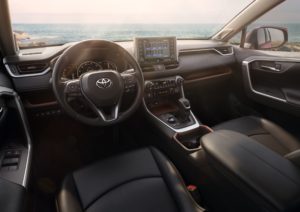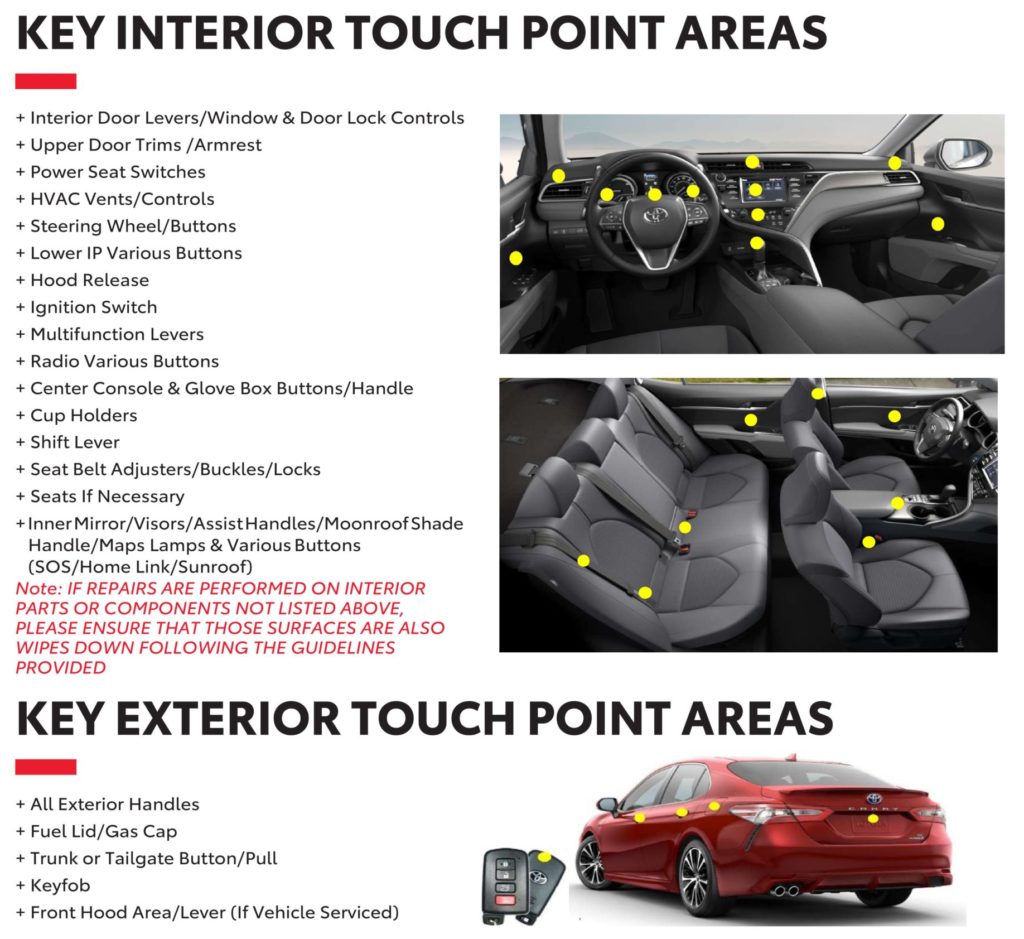
Toyota offers advice on disinfecting its vehicles for COVID-19
By onAnnouncements | Associations | Business Practices | Education | Repair Operations
Toyota has issued a list of interior and exterior components repairers and dealerships should disinfect on the OEM’s vehicles.
The guidance also includes a list of which Environmental Protection Agency-approved COVID-19 disinfectants are acceptable to use on its cars.
Toyota released the document ahead of another vehicle sanitation resource: the Society of Collision Repair Specialists’ free webinar Tuesday, April 28, featuring “professional restorers experienced in restoration, decontamination and infectious disease control.” Register for that 1 p.m. ET event here.
Recent insurer communiques describe acceptance of shop charges for disinfecting customer vehicles at intake and delivery, and the Toyota guidance Monday supports cleaning at those times.
“• Toyota recommends disinfecting vehicles when a vehicle is brought in for service, when it is returned to a customer, when a vehicle is taken from inventory for a test drive, and when a used vehicle is taken into the dealership as a trade or from auction,” Toyota wrote in the dealer-facing advice.
“• If a vehicle may have been exposed to someone with COVID-19 do not touch it for 24 hours, then disinfect it.
“• Utilize steering wheel, seat, gear shift, and floor mat covers in customer vehicles.” (Minor formatting edits.)
The Centers for Disease Control has issued general recommendations for companies on how to clean and disinfect during clean and disinfect during regular operations. For example:
“Routinely clean and disinfect all frequently touched surfaces in the workplace, such as workstations, keyboards, telephones, handrails, and doorknobs.
“… Provide disposable wipes so that commonly used surfaces (for example, doorknobs, keyboards, remote controls, desks, other work tools and equipment) can be wiped down by employees before each use.”
It also has issued recommendations if someone confirmed or suspected to have had COVID-19 has visited. For example:
“Cleaning staff should clean and disinfect all areas such as offices, bathrooms, common areas, shared electronic equipment (like tablets, touch screens, keyboards, remote controls, and ATM machines) used by the ill persons, focusing especially on frequently touched surfaces.” (Emphasis CDC’s.)
Toyota tells shops to focus on “high touch areas,” including seat belt components, visors and the gas cap. Toyota lists more than 20 parts inside and outside the vehicle — and says going deeper into the vehicle body opens up new surfaces to disinfect.
“IF REPAIRS ARE PERFORMED ON INTERIOR PARTS OR COMPONENTS NOT LISTED ABOVE, PLEASE ENSURE THAT THOSE SURFACES ARE ALSO WIPES DOWN FOLLOWING THE GUIDELINES PROVIDED,” Toyota wrote. (Emphasis Toyota’s.)
The agency recommends disinfecting with products on the Environmental Protection Agency’s List N.
Toyota supported using substances approved by the EPA, but would like repairers to avoid certain items on the master EPA list.
“EPA publishes a comprehensive list of registered/approved disinfecting solutions that have been deemed effective against Human Coronavirus,” Toyota wrote. “Because not all EPA approved disinfecting solutions are compatible with Toyota vehicle interior/exterior materials, Toyota compiled an excerpt list of EPA approved disinfecting product types that are suitable for our vehicles.”
The OEM noted that the EPA’s list could change — as of early Monday evening, the EPA list had been updated as recently as April 23 — and told shops to check with the agency to keep current.
Toyota said it didn’t want repairers to use Hydrogen Peroxide, Sodium Chlorite, Sodium Hypochlorite (chlorine bleach), Glycol Acid, Octanoic Acid, Hypochlorous Acid and any cleaning solution that contains silicone. …
“Any disinfectant product dispersed by a pressurized aerosol container is not recommended. Similarly, the use of steam or direct spray of liquids onto vehicle’s interior panels, electronics components or permeable material is not recommended.”
The EPA said it developed its “Emerging Viral Pathogen Guidance” in 2016 and used it for the first time with COVID-19.
Even after the OEM and federal messages, repairers might still have questions about cleaning customer vehicles during a pandemic. SCRS’ webinar Tuesday might help bring clarity here.
Encircle business development Vice President Kris Rzesnoski, Gearhart and Associates founder Norris Gearhart, Property Insurance and Restoration Conference administrator Jordan Hendler and European Motor Car Works owner Kye Yeung will join SCRS Executive Director Aaron Schulenburg for the event at 1 p.m. Tuesday, April 28. Register for the free event here.
“The conversational webinar will explore topics on how to manage customers’ expectations, and what practices, processes and disinfectant agents work – and which ones don’t,” SCRS wrote in a news release last week.
SCRS has also cautioned repairers to examine how they communicate vehicle sanitizing to customers.
“We’ve also seen examples of businesses promoting services to ‘clean’, ‘sanitize’ or ‘disinfect’ customer vehicles,” SCRS wrote. “The Society of Collision Repair Specialists (SCRS) urges caution with the language used in your promotion of services. For instance, your facility can assure that you ‘apply disinfectant’, but there is no testing protocol to ensure that you ‘disinfected’ the vehicle. In our interaction with other industries, this has been a repeated caution; describe only what you perfomed, rather than a promise of what it accomplished.”
More information:
Toyota COVID-19 cleaning and disinfecting advice for collision repairers
Toyota, April 27, 2020
Toyota “TIS” OEM repair procedures website
Society of Collision Repair Specialists, April 20, 2020
Register for SCRS COVID-19 disinfecting webinar
CDC interim COVID-19 guidance for businesses
CDC guidance for businesses with suspected/confirmed COVID-19 cases
Centers for Disease Control COVID-19 coronavirus portal
Environment Protection Agency “List N” of COVID-19 disinfectants
Images:
The interior of a 2019 Toyota RAV4 is shown. (Provided by Toyota)
Toyota has issued suggestions of surfaces repairers should disinfect against COVID-19. (Provided by Toyota)

